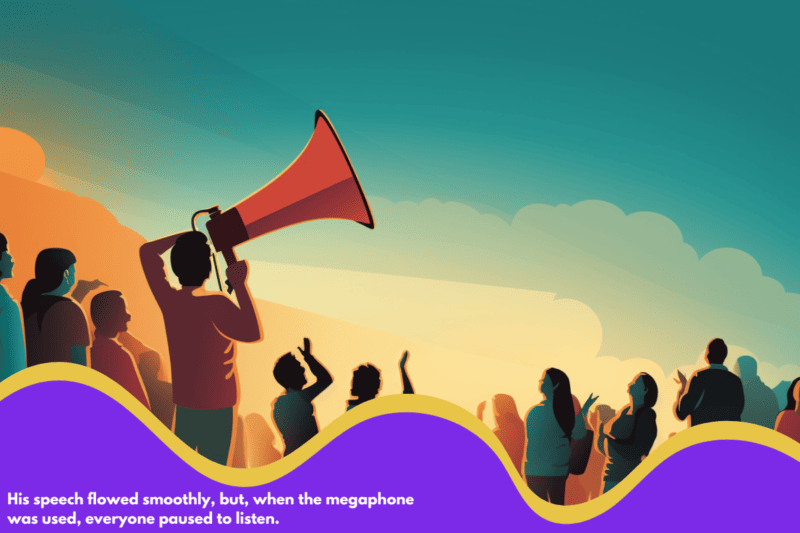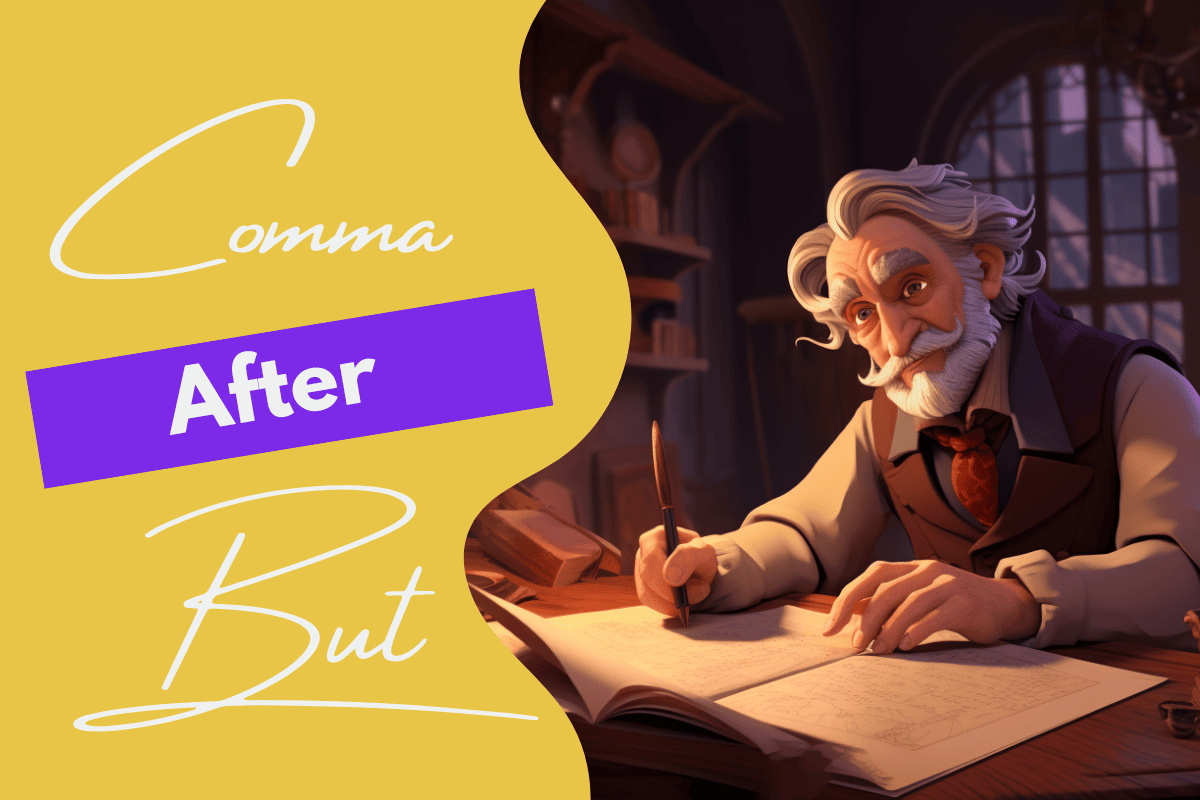But. It’s a simple three-letter word that can cause some real headaches when it comes to comma usage. You’ve likely been in this situation before. You’re writing a sentence that contains the word “but,” and suddenly, you freeze up. Wait, does this need a comma or not? And if so, does it go before or after the “but”?
I’ve been there too. Throughout my 15 years as a writer and editor, I’ve seen time and again how the rules for commas and coordinating conjunctions like “but” trip people up. And I’m at the head of that line. But have no fear! In this post, we’ll go through the ins and outs of comma usage with “but” in a way that’s straightforward and easy to digest. We’ll cover when you need a comma before “but,” when you need one after, and when no comma is required at all.
By the end, you’ll have a solid grasp of this one persistent comma question: Do you put a comma after but? Let’s dive in and start smoothing out those “but” comma wrinkles for good!
So, first, here’s the very short answer on when to use a comma before “but” and when to use a comma after “but.”
A comma should precede “but” when connecting two independent clauses. No comma is used when “but” joins an independent and dependent clause. A comma follows “but” only when an interrupting phrase immediately follows it.
Table of Contents
Key Takeaways
| When to Use a Comma Before “But” | When Not to Use a Comma Before “But” |
| Use a comma when “but” connects two independent clauses | Don’t use a comma when “but” connects an independent and dependent clause |
| Independent clauses can stand alone as complete sentences | Dependent clauses cannot stand alone and need additional context |
| For example: I wanted to go hiking, but it rained all day | For example: I wanted to go hiking but didn’t have the gear |

What’s the Deal with FANBOYS?

You’re probably familiar with the word “but.” It’s a handy little conjunction that joins two parts of a sentence together. Well, here’s a fun fact: “but” is part of a memorable acronym, FANBOYS!
These letters stand for other coordinating conjunctions like “for,” “and,” “nor,” “or,” “yet,” and “so.” We call them coordinating conjunctions because they coordinate or join clauses in a sentence.
When you use one of these FANBOYS words, like “but,” to connect two complete thoughts or independent clauses, you need a comma before it. Otherwise, the sentence gets confusing.
In this article, we’ll focus just on comma rules for “but.” But—see what I did there?—you can use these same guidelines for all the coordinating conjunctions. Pretty cool right?
If you really want to become a FANBOYS punctuation pro, check out our full article on punctuating sentences with these handy conjunctions. That one has a ton of great examples and tricks for commas with the whole FANBOYS gang.
For now, though, let’s get back to the scintillating subject of “but” commas!
When a Comma is Needed Before “But”

One of the most common places you’ll need to use a comma in a sentence is before the word “but.” Why is that? Well, it comes down to what “but” is connecting in your sentence.
You see, “but” can join together two different types of clauses:
- Two independent clauses
- An independent clause and a dependent clause
Let’s quickly define what those are:
- An independent clause is a group of words that can stand alone as a complete sentence. It has a subject and a verb and expresses a complete thought.
- A dependent clause is a group of words that cannot stand alone as a complete sentence. It does not express a complete thought and needs to be connected to an independent clause.
Here’s a quick example to illustrate the difference:
Example: I went to the store because I needed milk.
Independent clause: I went to the store.
Dependent clause: Because I needed milk.
Notice how only the independent clause makes sense as a full sentence? The dependent clause leaves us hanging!
Okay, now that we’ve gotten that straight, let’s get back to comma usage with the word “but.”
The rule is this: Use a comma before “but” when it’s connecting two independent clauses.
Example: I wanted to go to the beach today, but it’s supposed to rain all day.
Example: Shane studied hard for the test, but he still didn’t pass.
In both cases above, “but” is joining two clauses that could stand alone as sentences. That signals you need a comma before “but” to separate them.
Let’s look at a couple of examples where no comma is needed:
Example: I wanted to go to the beach today but couldn’t take off work.
Example: Shane studied hard for the test but didn’t pass.
Do you see the difference? In both sentences, the clause after “but” is dependent. It cannot stand on its own as a complete thought, so no comma is used.

To summarize:
Comma before “but” = Yes, when joining two independent clauses. The clauses could stand alone as complete sentences.
Comma before “but” = No, when joining an independent and dependent clause.
It’s as simple as that! Now let’s move on to the question of commas after “but.”
When a Comma is Needed After “But”
In general, it’s pretty rare to need a comma after “but” in a sentence. However, there is one case where a “but” should be followed by a comma—when an interrupter directly follows it.
What’s an interrupter, you ask? It’s a little word or phrase that interrupts the flow of a sentence, usually to add emphasis. Common interrupters are “however,” “therefore,” “meanwhile,” “for example,” and “of course.”
Here’s a quick example with the interrupter “of course”:
Example: I didn’t think I would like the movie, but, of course, it was excellent.
Notice how “of course” is an interrupter here, emphasizing that the movie being excellent is obvious or to be expected. Let’s look at one more:
Example: We could take the train to Chicago, but, certainly, the bus may be cheaper.
In this case, “however” is inserted to interrupt the flow and add contrast between the two parts of the sentence.
The key is that when an interrupter comes directly after “but,” you need a comma both before the interrupter and after it to set it off from the rest of the sentence.

So, in summary:
Comma after “but” = Yes, when “but” is immediately followed by an interrupter word or phrase. Use commas on both sides of the interrupter.
Comma after “but” = No in all other cases.
Pretty straightforward, right? Now let’s look at some cases where no comma is needed at all with “but.”
When No Comma is Needed
Believe it or not, there are also plenty of cases where no comma is needed before or after “but.”
As we discussed earlier, you don’t need a comma when “but” joins an independent clause and a dependent clause. Let’s review those types of sentences again:
Example: I wanted to go to the beach today but couldn’t take off work.
Example: Shane studied hard for the test but didn’t pass.
Because those dependent clauses can’t stand alone after “but,” no comma is used.
However, there’s another situation where you don’t need any commas with “but”—when it’s connecting phrases rather than full clauses. For example:
Example: My favorite season is autumn but not winter.
Example: She wanted to read a book but not a textbook.
Do you see how “but” is connecting phrases rather than clauses here? There’s no subject and verb after “but,” just a shortened phrase or fragment. In these cases, comma usage is unnecessary.
Here are a few more examples:
Example: He’s a pleasant coworker but kind of uptight.
Example: They decided to walk instead but soon regretted it.
Example: I’d like to see that movie but not until it’s out on video.
No commas are needed in any of the sentences above since “but” is joining phrases rather than complete clauses.
The main point to remember is that if you’re ever unsure whether to use a comma with “but,” just break the sentence into individual clauses. If each clause before and after “but” is independent (can stand alone), then include a comma. If not, leave the comma out unless an interrupter is present after “but.”
To determine whether a comma should accompany “but,” break the sentence into clauses and include a comma only if both surrounding clauses are independent, unless an interrupter phrase follows “but.”
By the way, if you’ve ever been puzzled about using a comma after “that” or “then”, then these enlightening articles on our site are just what you need. Enhance your grasp of the parts of speech with our guide on the use of a comma after ‘that’ and deepen your understanding by exploring the rules of a comma after ‘then’.
Where Does “But” Fall in the Sentence?

Now that we’ve covered the basic comma rules with “but,” you may be wondering… do these rules change depending on where “but” shows up in the sentence?
Let’s break it down based on “but” at the beginning, middle, or end of a sentence.
Do You Use a Comma After “But” at the Beginning of a Sentence
It’s perfectly grammatical to start a sentence with the word “but”—you’ll see it done often in writing. For example:
Example: But I didn’t know you were coming to town next week!
When “but” starts a sentence, the comma rules we’ve discussed still apply. There’s no need to put a comma after the “but” simply because it falls at the beginning of the sentence. The only time you’d need a comma after an opening “but” is if an interrupter directly follows:
Example: But, in fact, I didn’t know you were coming to town next week!
As with commas between clauses, look at what comes after the word “but”—a dependent clause, independent clause, or interrupter? Based on that, apply the same comma rules we’ve covered.
Do You Put a Comma Before or After “But” in the Middle of a Sentence
When “but” falls in the middle of a sentence, you have more flexibility in comma usage since you may need commas both before and after:
Example: I wanted to go to the party, but, unfortunately, something came up at the last minute.
As you can see here, you use a comma before “but” because it separates two independent clauses. You use the comma after “but” due to the interrupter word “unfortunately.”
This illustrates how thinking about clause types and interrupters on both sides of “but” is key when determining middle-of-sentence comma placement.
Do You Use a Comma Before “But” at the End of a Sentence
It’s rare in formal writing to see “but” placed at the very end of a sentence. Typically, “but” joins clauses within a sentence rather than ending the thought completely.
However, in dialogue, you may see sentences that trail off with an abrupt “but…” as in:
Example: “I was going to go along, but—” protested Mark.
This fragment with “but” leaves the reader hanging, emphasizing the interrupting nature of the dialogue. Outside of creative writing, avoid using “but” at the end of sentences in formal prose.
The position of “but” in a sentence doesn’t change the basic comma rules—just apply the clause and interrupter guidelines and you’ll be all set!
Phew, we covered a lot of ground on these “but” comma rules! Let’s turn now to some common mistakes people make in comma usage with “but” so you know what to avoid.
Common “But” Comma Mistakes

Now that you understand the basic rules for comma usage with the word “but,” let’s go over some of the common mistakes people make:
Comma splicing
This happens when you use a comma to join two independent clauses where a period or semicolon is needed. For example:
Incorrect: I wanted to make cookies for the bake sale, but I forgot to buy ingredients. ❌
Correct: I wanted to make cookies for the bake sale, but I forgot to buy ingredients. ✅
Run-on sentences
Similar to comma splicing, a run-on sentence incorrectly joins two independent clauses with no punctuation at all. For example:
Incorrect: I wanted to make cookies for the bake sale but I forgot to buy ingredients. ❌
Correct: I wanted to make cookies for the bake sale, but I forgot to buy ingredients. ✅
As we discussed earlier, commas are only needed before “but” some of the time. You have to look at the specific sentence structure.
Missing commas around interrupters
It’s easy to forget that interrupter words after “but” need to be set off with commas. For example:
Incorrect: I wanted chocolate chip cookies but of course forgot to buy chocolate chips. ❌
Correct: I wanted chocolate chip cookies, but, of course, forgot to buy chocolate chips. ✅
By being aware of these common errors, you can catch yourself and correct any “but” comma mistakes in your own writing. It just takes practice!
Now that we’ve gone over the fundamentals let’s look at some nuances of “but” comma usage across different kinds of writing.
“But” Comma Usage in Different Writing Styles

The basic comma rules for “but” apply across the board, from academic papers to text messages. However, there are some interesting differences and exceptions when it comes to “but” comma usage in certain writing situations and genres.
In formal academic and business writing, precision with “but” commas is critical. The guidelines we’ve discussed should be followed strictly in papers, reports, official emails, and the like. You want your writing to be grammatically flawless in these contexts.
In fiction writing, though, creative liberties are often taken with comma rules. Fiction authors may intentionally leave out commas before “but” or add commas after “but” purely for stylistic reasons related to sentence rhythm and cadence. Since fiction dialog also tries to mimic natural speech patterns, you’ll see “but” used in incomplete sentence fragments more often.
Example:
“I wanted to join them, but—” said Mark.
“But what?” asked Sarah.
As you can see, fiction allows for more playing with punctuation like “but” commas versus formal academic writing.
In casual everyday writing like text messages, chats, and emails to friends, “but” comma rules tend to be relaxed. Most people don’t carefully construct complete sentences when texting or chatting informally. You’ll see abbreviated sentences, sentence fragments, and commas used (or omitted) based on personal texting style preferences rather than proper grammar.
Example: Hey, sorry but I can’t make it tonight! Maybe next week?
In informal writing contexts, casual comma usage with words like “but” is perfectly fine—you just want to convey your meaning. But in formal writing, be sure to punctuate “but” properly!
Some More on Commas and “But” and the Rest of the FANBOY Gang!
Helpful Tips for Accurate “But” Comma Use
If you’re still struggling with deciding when to use (or not use) commas with “but,” here are some handy tips:
- Read your sentences aloud: The natural pauses in your speech can help you identify independent versus dependent clauses. Pause before “but” if you’re joining two clauses that could stand alone.
- Break apart clauses: Separate the parts of the sentence into individual clauses. Does each clause have a subject and verb? If one doesn’t, then you likely don’t need a comma.
- Reference a comma guide: Keep a comma usage chart handy while writing to refer back to. Having a quick refresher on comma rules is useful.
- Focus on “but” commas in editing: It’s easy to lose sight of precise comma usage in drafting. Make “but” commas a focus area during your editing passes.
- When in doubt, read up on comma use: There are tons of in-depth comma guides online to improve your overall comma skills.
With practice over time, placing commas appropriately around coordinating conjunctions like “but” will become second nature. It just takes repetition and awareness! The more you pay attention to “but” comma usage, the more automatic it will become.
Boost your grammar game! Discover the art of using a comma after phrases like ‘until next time’ and ‘normally’ with our concise guides.
The Takeaway: Mastering “But” Comma Use
Holy moly with a dash of incredulity on top (the cherry was missing in action), you actually got to the end of this monster. You deserve an award! Honestly. A big, fat shiny one. But just stick with me for a wee bit longer.
So, does the comma go before or after “but”? By now, you should have a solid grasp on comma usage with this common coordinating conjunction. The key is simply to identify what “but” is connecting in your sentence—independent or dependent clauses, phrases, or interrupters.
Though it may take some practice, keep at it with these “but” comma rules in mind. Soon you’ll be punctuating sentences with “but” confidently and correctly. No more but-related writing anxiety!
Now that you’ve got this concept down pat, pick another punctuation mark to master next. Before you know it, you’ll be a comma—and writing—expert. Don’t hesitate to let me know if you need a refresher on any grammar or punctuation topics in the future!
FAQs
What if “but” is connecting two verbs that share the same subject?
You still need a comma before “but” if the verbs could stand alone as two separate sentences. For example: “John walked to the store, but he drove back home.”
What if “but” is connecting two nouns or noun phrases?
You don’t need a comma, since nouns alone don’t make an independent clause. For example: “He ate an apple but not an orange.”
Do you need a comma if “but” appears right after the subject?
No, in this case “but” is not joining two independent clauses, so no comma is needed. For example: “John but not Mary went to school today.”
Is a comma always required before “but” if the subject is omitted from the second clause?
No, a comma is only required if the second part could stand alone as a sentence on its own with the subject included. For example: “John took a shower but didn’t wash his hair.” No comma is needed here.
Should there always be a comma if “but” interrupts a list of items?
No, a comma is not required when “but” interrupts a list. For example: “At the store he bought milk, eggs, butter but not cheese.”
Do you have to use a comma if “but” starts a dependent clause?
No, if the clause after “but” cannot stand alone, no comma is needed. For example: “He would have gone but that he was sick.”
Is a comma needed if “but also” appears in the sentence?
No, “but also” joins two verbs that share a subject, so no comma is used unless an interrupter appears after “but also.”
Should commas always surround interrupters after “but” even if informal?
Strict grammatical rules call for commas around interrupters in all writing. However, in informal writing like texts, interrupters may not always be set off with commas.
Does the comma go before or after “but” if writing a bulleted list?
The same comma rules apply. Use a comma before “but” if joining two independent clauses.

